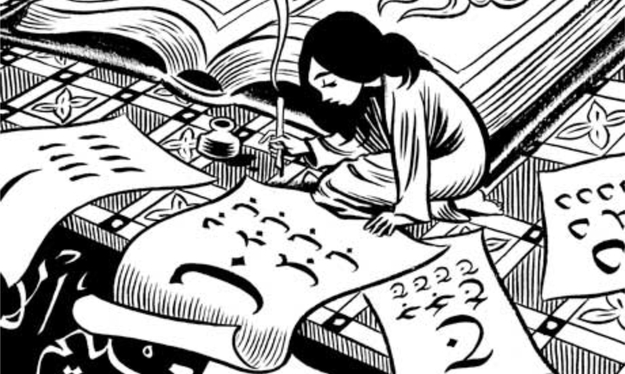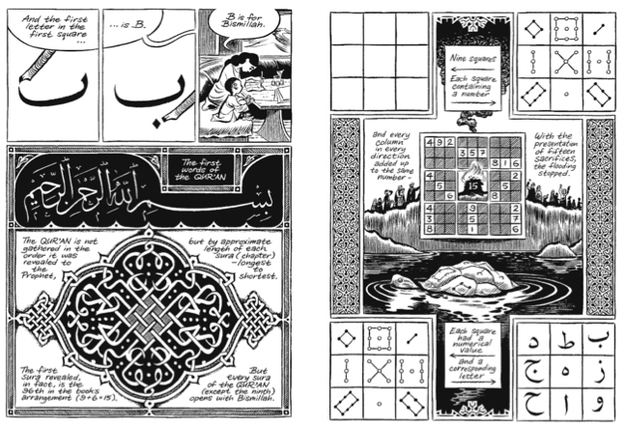This book truly is an artistic masterpiece, an overload of obsessive details and rich visual content. It is a stark contrast to Thompson’s previous mammoth novel, Blankets, a much gentler and highly personal autobiographical story about Thompson’s childhood, growing up in a very religious household while trying to navigate the guilt and wonder of sex and a first love. By contrast, Habibi is a fictional tale, which shares to some extent Blanket’s themes of love, religion and sex. Only this time, the tale is grander, deeper, and much more layered.
Habibi transports us to a fictional yet strangely familiar time and place, which feels almost post apocalyptic. We see evidence of a fallen civilization on the brink of an environmental disaster, and the haunting degeneration of humanity. We meet our heroes, Dodola and Zam as young orphaned children, connected by tragic circumstances. At the onset of the story, Dodola becomes the child wife of a Koranic scribe, giving her great insight into religious texts, which she uses as a measure to cope with her life’s challenges. Every event in both her and Zam’s journey is layered with Dodola’s religious metaphors. Every hardship is eased with tales of sacrifice and faith. These intermittent moments break up the larger plot, but are beautifully weaved through in a tapestry of Islamic patterns, calligraphy, numerology and mystical teachings. At its heart, Habibi is a love story. Thompson explores the mystical nature of human love, as well as the wider and infinite nature of the universe. Humanities weakening connection to nature and water also play a huge part.
With such rich and heavy material to work with, Thompson had to clearly do his homework. His Arabesque patterns frame every chapter by setting its tone, while his calligraphy enriches and informs the pages it adorns. There is a natural ease in the transition between these elements and the rest of the work, which happens intermittently throughout the novel. Never did it feel visually jarring. Quite the contrary, Thompson’s illustrative style perfectly marries the dramatic yet highly considered Arabesque patterns and calligraphic strokes. His chosen calligraphic style is predominantly classical and traditional in form, the content of which relies heavily on Islamic verses and phrases, as well as the basic Arabic alphabet. This is only appropriate given the plot and storyline. A looser Arabic script is attempted on some pages, which doesn’t work as well. Most readers will only appreciate the script for its visual beauty, but for those who can read Arabic, be warned, it can get a little frustrating. There are unfortunate instances where the translation of certain words fail the narrative, so one must take a step back and remember to consider Thompson’s use of Arabic as visual and not literary content. I have myself forgiven him for that, there is far too much to appreciate in this true labor of love. His mastery of the human form and the blending of his drawing style with calligraphy and Arabesque patterns make each page a visual marvel. Thompson does not disappoint.
One thing is certain, It is hard not to have an opinion about this book, it’s mere scale is mind bobbling, a staggering 672 pages of consistently impressive work. And as much as I do praise and love Habibi, I did find the story could be complex at times, perhaps a little over indulgent. Like eating an oversized double chocolate cheesecake, it tastes amazing at first, but too much will leave you with a sugar induced headache. This is the only critique I really have of this book. It can be a little too much for a little too long. Habibi does remain however, one of my all time favourites, and definitely a book I would read over again, or just flip through lightly, only to marvel at its beauty and genius. I highly recommend it, and even insist that you read it.


